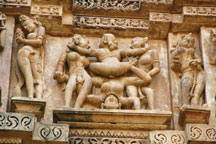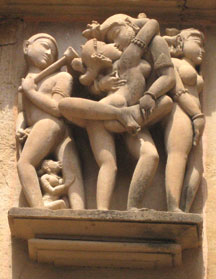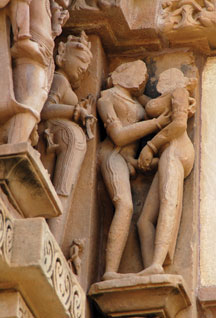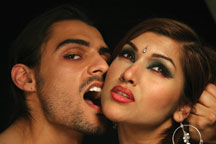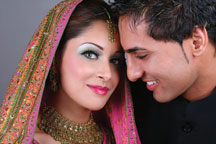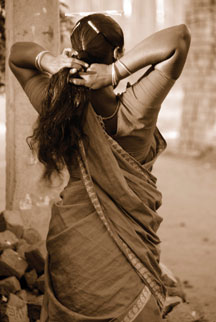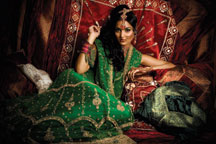Arts
Let's Talk About Sex

Without senses, we would not know we are alive. And with senses, we know how to live.
|
When we think of ourselves, “sex” is not the first characteristic that comes to mind. Italians and Brazilians are clearly identified as sexual, but not Indians. Exotic perhaps, but certainly not sexy or sexual. But we are sexual beings. After all, we must engage in it more often than the average global citizen. We don’t believe in immaculate conception or divine intervention on a daily basis, so it must be the increased activity of sex that has procreated a population of a billion.
When we arrive here from the place that shaped our sexual identity, we are in conflict with several worlds, including our own. From the moment we step out of India, our conscious pursuits may be for money or knowledge, but our existence holds an intensely sexual dimension to it. One constant refrain at “foreign” student offices in universities around the country during orientation programs is that the “foreigners” should not mis-interpret the friendliness of American women as anything more than that, an expression of casual friendliness. We migrate, or return home, in the Indian purushartha tradition – in pursuit of Artha (money) or Moksha (liberation), or with a grave sense of Dharma (duty) to self or family. The pursuit of the fourth Hindu life principle, Kama (sensuality), is rarely touted.
That is strange considering that we come from one of the most fertile lands in procreation. We bring with us a heritage of nude and erotic sculptures and that great text Kamasutra, which preceded our arrival and introduced us to the West. We immigrants straddle many worlds, two of which form our frontiers of where we come from and where we are. The realm of sexuality – sex, sensuality and all things sexual – is not that pronounced, But the codes and conflict of these worlds are at play in our family relations, our new social networks, perceptions in the media, as well as in the motivation to make sense of it all. Our sexual identity is a mix of many worlds. It is a challenge that would have even befuddled Freud. The great Dean of sexuality could comprehend a nuclear, patriarchal family, stable in a culture where patterns are predictable and desires are unchallenged beyond their norms. But is it possible to understand the various manifestations, reactions, implications and narratives of sexuality for immigrants, the people who oscillate between boundaries? India is a puzzle for those willing to think and a simple riddle for those bent on forming an opinion. The culture of sex and sexuality in India is far too difficult to be understood in all its dimensions. There is the age-old conflict between tradition and modernity or the nativist and the commercial culture in India. We are coded in our sexual behavior. We shy away from pre-marital sex and sex education is taboo in schools. We seem to keep our distance from the other gender and that too, by limiting the movements and gestures of women in the family and the public space.
We are a prudish society that does not seem to know how to be comfortable with sex and sexuality, mutual gender or in shaping our desires into elegant or respectful gestures in public. The boundaries between sexes are marked and the rights of puberty are masked by either religious rituals or glossed over by parents and family. Since most Indians live in joint families, this is even harder as we see around us clear expressions of “sexiness” and fully sexual beings. Families that live in smaller living space have to be very cautious and considerate, often talking about sex in coded terms, mostly in hushed tones. Courtship in India is remarkably un-natural. We talk to girls from fifteen feet, rarely breaking the unspoken codes of restraint and respect with purer, freer expressions of feelings. We are indeed devoid of languages for courtship. In a very odd manifestation, we sing Hindi film songs or quote poetry to make our feelings known, in rich metaphors with hardly a connection to the heart of the man or a woman we are approaching.
I have observed more than once incidents of the fresh grooms asking for appropriate verses to use in the closely observed courtship rituals and even on the first night of their lives. We have a mythology of sexuality in Indian cinema, which assumes that the culture is prudish, reserved and quite harsh on itself. Expressions of sexuality and true awakening of sexuality are always taboo; we think speaking of it will make us all dirty or violate our divine command of chastity and purity. As we look back on the life we left behind, sexual awakenings appear to be fugue, a cloudy mish-mash of missed opportunity, encounters with codes and the authorities that imposed them. Very few of us, particularly in the middle class, broke open those boundaries and enjoyed ourselves. Things have altered a bit for the newer urban middle class. Their proximity and Western style consumerism has brought them closer, physically and perhaps sexually. The path of their lives is not that liberated or clear. While they do enjoy somewhat of a clearer encounter with things sexual, their later rituals, marriage and family life allow them to lapse into the Indian prudishness toward sexuality. You must be careful about sex, not appear sexy; sex is not a public topic and one does not talk about one’s sexual desires or experiences in public. Reserved as we are in engaging with matters of sex and sexuality in expressive form, there are part of our lives that are intensely sexual. Indian clothing, particularly that of women, has been seen as sexy (also elegant, respectful, etc.). The calculated exposure of the blouse design and the curves that make a sari, revealing what has only just
become fashionable in the West, the mid-riff, all speak of intentions to move the body in front of others, defining what is sexy and how artful that sexiness can be. Other forms of dresses, including skirts, salwaar-khameez, etc. have their own distinct, inviting features that are pleasing to the eye and in their variety, unmatched anywhere. Contrast that with mini skirts or tank tops, jeans with ever widening mid-riffs. Western clothing is less colorful, less charming and hardly artful. This in-your-face sexuality is not something Indian clothing practices and that is something very sexy indeed. We clothe our prudishness in seductive, colorful and distinctive clothing. That may well be a metaphor for how we see sex and sexuality in India, because after all, that is where our sensibilities are shaped. Outside of the limits of the personal or the familial, our streets are exploding with sex. There are billboards with giant breasts, gyrating hips posed to eternity, and a combination of animalistic roughness in our heroes and villains, surrounded by voluptuous and inviting beauties. In films, sex is not simply an expression; it is an underlying theme, a reward for the victories of men and a feast for those who pay for the tickets. There is hardly graphic sex in Indian movies, but its underlying tenor is obvious. There are aggressive courtship gestures and incredibly loaded language to suggest sexual unions, elevated to the poetic, but erotic nevertheless.
The explosion of commercial culture during the past 15 years has exacerbated these trends. What was once the province of Bollywood, has been taken over by the commercial industry, which has cashed in all the repressed sensibilities of Indians. It is so much in your face that even children are now aware of the parts of women’s bodies and their personal rituals. It is hard to imagine that you are in a culture that is reserved about matters of sexuality. Bollywood and commercial culture are deepening the fantasies of a prudish nation. As cultural norms persist, they fantasize about their sexuality through a sexy Zeenat Aman or Dimple, perhaps Aishwarya Rai or Madhuri Dixit, but they return to their own reality, which holds an enormous weight in matters of the flesh. The key here is the moment of wedding, either in the film or in the lives of these Bollywood babes. Since most Bollywood narratives end in marriage, there is no life to these real life sexy divas after marriage. We see a return to classical prudishness. It is now simple clothing, family life and press briefings without make-up.
Perhaps all this sex and sexiness in Indian culture is at the level of fantasy. But it allows us, in fact, forces us to live in two worlds. We live cautiously to explore and practice sexuality, to talk about it or even learn about it (sex education is not possible in many states). And yet, we watch our public world explode with sexual images, narratives and fantasies. The visual character of Indian street, among other things, is intensely sexual. But it is a street of a culture that practices sexuality as if it is the last caution against the human body. We immigrants carry it all here. Our perceptions of sex and sexuality in this culture are shaped by Hollywood movies, TV shows, gossip programs and the vast publicity machine that creates America for immigrants even before they arrive here. On the face of it, America is very open and free. Sex, we are told, is like money, you will find it anywhere if you look for it. Issues like premarital sex, sex education in schools are quite common in public life. The status of relationships, even that of family, is fluid. One can have many partners, some official, some not. There are fewer taboos in terms of the interpersonal practice of sex. Sexuality is still the currency that drives consumer culture. Everything is sexual. It is hard to take your 5-year-old to a mall and let her think that it is all a display of things that can be sold. But it is a society that lives with a relatively open public exchange about sex. Homosexuality is a common, public subject. If you listen to a fanatic right winger, you might find that in his rage-ridden commentary, he takes interest in describing gay sex. Practitioners are not obsessed with it, so they do not describe it.
This culture does not have a grip on simplicity when it comes to sex and sexuality. It is also, much like ours, a deeply ambivalent culture. It is beset with contradictions that are less rich and verge on hypocrisy. Remember the brouhaha over the exposed 40-year old breasts of Janet Jackson during Super Bowl half time? No one seemed to balk over commercials on the same show for drugs for overcoming erection problems. This culture is ridden with such contradictions. There is Hollywood, along with the largest pornographic industry and a highly charged consumer culture where advertisers like Tom Ford, shamelessly cross the boundaries of sexual humiliation of women. The right screams and schemes about constraining sexuality in this country, spending millions teaching teenagers to retain their virginity. The schisms are so deep that they seem to drive the psyche of the nation.
We arrive here and make this our new home. We bring with us our own contradictions that would be inexplicable to outsiders and even to ourselves. But we land in an equally deep morass of confusion and duplicitous practices about sex and sexuality. This encounter, unique and distinct, has its challenges, generating crises and confusions. Just as we think Americans are open and free about sexuality, Americans seem to think of us as sexually rich and even complicated. For outsiders, we are the inheritors of Kamasutra clearly the best known text on sex and sexuality. When in India, we did not read it or live by it, but now, we have to confront it. There are many misconceptions about it, but it still remains a text from India which the publishing industry has made its own. We are misunderstood by Kamasutra as much as Kamasutra is misunderstood by us.
As we navigate through the contradictions, we have to also live with representations of ourselves. From The Simpsons to Sex and the City, there are references, jokes, and hyperboles about the incredible prowess of Indians in matters sexual – the 14-hour orgasms, umpteen numbers of acrobatic sexual positions, etc. We may be dunces in popular culture and The Simpson’s Apu may have made himself quintessentially Indian, but in matters of sexuality we have Herculean capacities. All fiction, all fantasy, but we live with their realities. We have to raise families in a culture that is so diametrically contradictory and very loud about those contradictions. Our daughters have to date in this culture – an idea that evokes nightmares in the minds of most immigrant parents. Our sons bring home their American girlfriends and we worry if she might spoil the well-kept prudish character that marches as tradition. Our wives, who hardly engaged in public conversations with men back home, have to work in public spaces. Men meet women in their workplace. How do you finesse manners that you did not learn before? Shah Rukh Khan, his glasses and jackets helped you a little in India. That role playing made moments pass. But now, simple encounters and courtship in a culture that has its own neurotic contradictions are not easy. This is where theory collapses. We now have to figure out new modes and strategies of living. If it is not this or that person, then it is the entire culture that is out to teach you how they view sexuality, how they practice it, market it, condone it and condemn it. Sex, more than money, makes us who we are. It informs our psyche, generates conflicts, sleepless nights and also postures of thinking.
As we venture out of our cocoons, there is world to see, to meet and even to live with. There is a world to be made love to. We have to understand where we are, who we are meeting, what shapes their attitudes and what we and they bring to encounters. This requires effort at thinking for ourselves, for others and also for what we have brought with us. Sex and sexuality are not all consuming desires, but they are fundamental to our existence. But it is easy to prescribe than to practice. The close encounter of the world of the immigrant, who has brought the conflicting world of prudish, restrictive values, with the rich heritage of pioneering sexuality and a public exhibition of sexuality from home has to confront another chasm here: that between the apparent openness and freedom on the one hand and the restrictive moralistic orthodoxy on the other. Even Freud would find this impossible to navigate. Before we contemplate what insights our own tradition can provide, let us also think about how deeply pathological our orientation in this world could be when it comes to sex and sexuality. We own an imaginary heritage in India without knowing how complex and challenging and fluid it has been all along. Given the rigidity of contemporary Indian thought, we forget that India’s greatness lay in its plurality and its eternal flexibility in everything. We are not a dogmatic people. We cannot impose our selective morality upon the next generation. Theirs is a world of their own. Our spouses, brothers and sisters may all be charting their paths in something that is fundamentally natural. In fact, there is no guilt associated with sex in Indian tradition and sex is not performed in the name of some divine powers. So we must be less pathological and restrictive. We ought to be aware that our regressive reactions may well be caused by the conflicts of values that are playing out in our minds.
We moved from one set of dubious commitments to another when we transplanted ourselves into this culture. Our confusions and bewilderments are richer than any one else’s. There are more fundamental problems that affect our personal lives, such as the sexual mores and perceptions. There is your daughter’s dating plans or your marriage to a woman from another culture. There is always a clash, a conflict, but always an opportunity to make things more complicated than what may have been. When we walk around in this culture, we are instantly Indian, of course. But we are also rich in our sexuality. After all, we wrote Kamasutra, one of the best selling book about sexuality. The 1960s sexual liberation was as much about the “awakening” of sexuality catalyzed by the encounter with India as it was about finding one’s self in a rigid and traditional culture.
Confronted with all this, we Indians are not quite open in aligning ourselves with our own history. Kamasutra or not, India has a tradition of sexuality that is integrated in ways of life, culture and even religion. After all, Kama is one of the paths of life. It does not carry guilt. It is not pursued because we are answering the call of some divine powers. It is pursued because you are born for it. It is an essential activity that gives meaning to who you are and what you want to be. It is a path of life that requires dedication as much as pursuit of money and enlightenment needs your well-defined commitments. As messengers of a culture that is richer and one that placed sex, passion and sensuality on the same level of worship of divinity, we ought to understand Kamasutra better. The gift and insight Indians bring to this world of hypocrisies and contradictions is the understanding that sex is a part of sensuality and that itself is our orientation in the world. It is this understanding that makes sex so rich, and not just pure bodily pleasure. The West is caught up in this dilemma as it separated the categories of pleasures that bodies can have and those that minds can articulate or experience. When the Indian tradition put Kama in the middle of all the other human paths, it showed how passion and sensuality are not about bodily pleasures, not about here-and-now and certainly not about acrobatic sex or genital pleasures. It is about embracing an ethic to approach everything. It is time to claim that richness and not be embarrassed by the sexual insights that the Indian tradition offers. For the greatest gift we have that separates our existence from now until later, after death, in another form, is that we have senses with which we experience the world. Without senses, we would not know we are alive. And with senses, we know how to live. We cannot squander away these opportunities, but instead should embrace and understand them. One way to recognize the capacity of the senses and then to unleash their potential to establish ourselves in the world, is the embrace of another. It could well be a woman, a man or animals, objects around us, the ray of the sun, the comfort of the moon and the trickle of the rain. It takes effort to appreciate the great, intrinsic values of these fleeting moments. Despite the foolish ways we count time, there isn’t much of it we have until we can appreciate the capacity of our senses. It is for this reason that we immerse ourselves into what we have and in this case, it is sex. But it is also courtship, friendship, sound, and vision, everything that opens up as we meet others. Any distractions from this create confusion, reductive life styles and manuals that speak of means to illusory ends and abuse the human body. It is time to claim this heritage of our lives, our traditions, our temples and erotic sculptures. For Westerners, these are matters of flesh. For us, these are matters of spirit, thought, soul, all enabled by the body, which is the seat of the senses.
| |||||||||||||||||||||||||||||||||||||||||||||||||||||||||||||||||||||||||||||||||||||||||||||||||||||||||||||||||||

